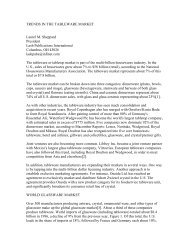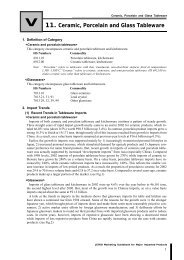eu market survey 2003 - crecer
eu market survey 2003 - crecer
eu market survey 2003 - crecer
Create successful ePaper yourself
Turn your PDF publications into a flip-book with our unique Google optimized e-Paper software.
3.2.2 Market segmentation by user<br />
In recent years, changes in lifestyle and trends have been occurring faster. Consumer behaviour<br />
has become more impulsive, especially in northern EU countries. Fashion is also an important<br />
indicator for trends in the table- & kitchenware <strong>market</strong>. Segmentation of consumers is becoming<br />
more important. Different styles and designs satisfy different groups. Below we present the major<br />
consumer groups in the table- & kitchenware sector.<br />
• Singles (young) This group consists of students and single-person households. The<br />
people in this group usually live alone; they spend more time out of their homes. They<br />
mostly perceive cooking as a chore. They mainly purchase low-priced table- &<br />
kitchenware which is functional and easy to use.<br />
• Couples (childless) This group consist of couples, where both partners are employed,<br />
resulting in higher spending power. They are increasingly sensitive to fashion and are<br />
more responsive to new and modern design trends. People in this group are important<br />
customers for premium designer table- & kitchenware.<br />
• Couples (parents) This group consist of people with young children. They are<br />
sensitive to fashion, but not as much as childless couples. The parents prefer convenience<br />
and dishwasher-safe, durable products to high-priced elegant items, which may get<br />
broken.<br />
• Older couples (middle-aged) This group consist of somewhat older people (baby<br />
boomers). In most cases, the children have left the house. These middle-aged people<br />
spend most of their leisure time at home, socialising with friends and family. They are<br />
gradually replacing and upgrading their current table- & kitchenware. The people in this<br />
group have high disposable incomes. Value-for-money and functionality are important<br />
purchase criteria’s in this group. They are less sensitive to fashion and mainly purchase<br />
the more traditional table- & kitchenware products.<br />
• Seniors (65+) This is the fastest growing consumer group in the EU-countries. It<br />
consists of retired people. In most cases these seniors move towards smaller houses.<br />
Value-for-money and functionality are important purchase criteria. These people mostly<br />
fancy traditional table- & kitchenware, which they have collected throughout their lives.<br />
• Hobbyists This growing group consists of people all ages. Because of the shift<br />
towards the convenience- and ready-made meals, consumers are freed from the laborious<br />
chore of creating family meals on a daily basis. Because of this development, gourmet<br />
cooking has become an occasional hobby for many people. They often purchase highend,<br />
expensive professional products.<br />
Catering industry<br />
According the Committee of the European Glass Industry, 28% of all glassware is sold to the<br />
catering industry (restaurants, hotels, bars). This shows how important the catering industry is to<br />
the entire table- & kitchenware sector.<br />
Because it uses table- & kitchenware extensively, the catering sector sets high demands on the<br />
quality of the products. Products need to be durable, heat-resistant, chip-resistant, microwaveand<br />
dishwasher-proof and have high hygiene standards. The more traditional table- &<br />
kitchenwares are particularly popular amongst the caterers.<br />
24





